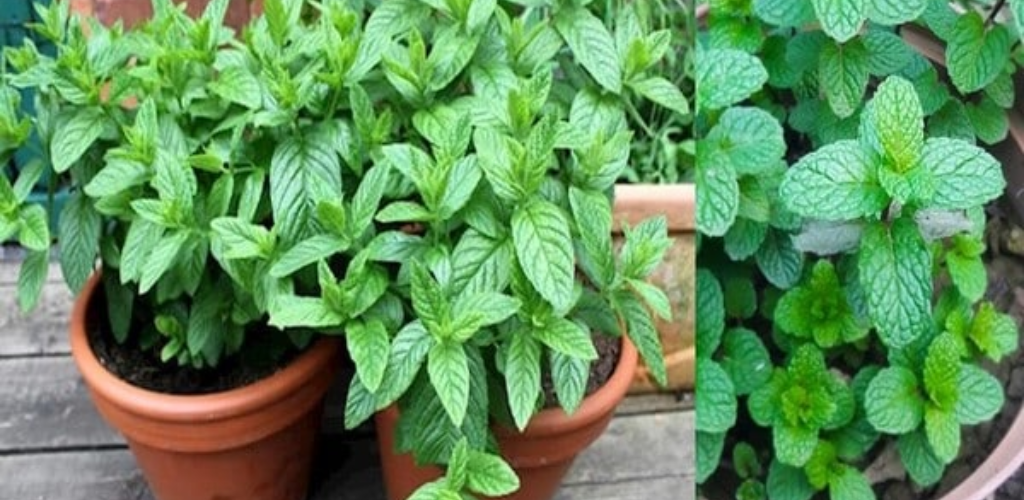10 Reasons You Should Start Growing Mint at Home (and How to Do It)
Mints are the perfect starting point for an herb garden. They are usually in a pot, because the species is extremely invasive, its roots run to take over the surrounding soil.
Discover 10 reasons why you should start growing mint at home
Attracts good insects: Mint keeps your garden or balcony full of “beneficial” insects. Mint nectar and pollen help maintain easy access to beneficial insects such as bees.
Natural repellent: Although it attracts “good bugs,” mint keeps away “bad” ones, like ants and mosquitoes. Mix water with mint essential oil and spray the solution near doors and windows.
Tip: Prepare a bouquet of 2 sprigs of fresh mint, 1 sprig of fresh thyme, and 1 sprig of mugwort and place it under the pillow or blanket your pet uses for a nap.
Home deodorant: Add a few drops of peppermint oil to your DIY (or eco-friendly) household cleaner.
Add Flavor to Your Drinks…: Add mint to your frozen drinks for a touch of freshness.
…And to food!: Add it to cooked or raw vegetables, peas, beans and carrots in the last minutes of cooking.
Desserts: add mint to desserts, it’s truly irresistible!
Freshen your breath: Chew mint leaves to say goodbye to bad breath, in just a few minutes.
Relieves Stomach Aches: A peppermint tea is a godsend for an upset stomach. Mint relaxes the digestive tract, relieves indigestion, intestinal gas and abdominal colic.
Relieves hiccups: Put a few mint leaves, a little lemon juice and a pinch of salt in a cup of hot water: relief will be immediate.
1-NUMEROUS VARIETIES
The different species of mint form a genus: Mentha. There are around 25 species, not counting the numerous cultivated hybrids.
- Spearmint (Mentha spicata): Native to North Africa, used for mint tea.
- Field mint (Mentha arvensis)
- Aquatic mint (Mentha aquatica): Found in very humid places, at the edge of water, it has a menthol smell.
- Peppermint (Mentha x piperita): Cross between spearmint and strong-smelling aquatic mint.
- Fragrant mint (Mentha suaveolens)
- Pennyroyal (Mentha pulegium): Widely used in Spain and Italy.
2 – HOW TO PLAN MINT?
There are several solutions available to you for growing a mint plant at home. You can :
- Buy a mint plant in a pot.
- Collect a stem with root from a lucky mint owner.
- Or make roots from a sprig of mint purchased in a bouquet in stores.
Indeed, soaked in water (or even directly in the ground) the mint stem stripped at the bottom begins to produce roots in a few days. It seems that this is how Cuban mint spread to the United States: collected in mojitos and brought back by tourists! - Mint can be planted throughout spring, from the end of March to the end of June.
3 – WHEN TO PLAN MINT?
Planting the subjects in pots: from March/April provided that it does not freeze. Planting in summer of cuttings taken the previous spring.
Prepare to plant mint
It is easier to obtain mint plants directly in pots or pots from stores than to sow mint.
Before planting, prepare the soil, weed and dig to loosen the bed which will receive the mint.
Incorporate well-ripened compost into the soil because mint appreciates fertile soil.
Mint is a very invasive plant: place an anti-rhizome barrier to delimit its space and prevent its roots from tracing or plant its root ball in a bottomless container to contain it. A zinc basin will do the job perfectly.
Exposure
Mint thrives in the sun, but it can also do well in partial shade.
Soil and watering
A rich, fresh soil is favorable for it: provide a humus-rich substrate when establishing it, and do not hesitate to regularly add compost to the surface. The organic matter thus released will nourish the soil and allow it to better retain its humidity. You can also place mulch around the base. If you install several legs, plant them at least 30 cm from each other. Finally, the soil must remain slightly moist: in summer, plan to water in case of drought, and water the potted plants regularly.
4-HOW TO MAINTAIN MINT?
Mint is a plant that requires little maintenance:
- Water the soil as soon as it is dry, but only in hot weather.
- From November, it is advisable to cut the stems a few centimeters above the ground.
- Weed and hoe.
- Pinch the ends of the stems so that new leaves appear quickly and the plant does not flower.
5 – HARVEST
You can pick mint leaves throughout the spring and summer as needed.
Preferably choose the most important leaves by cutting the entire stem to encourage the birth of new shoots.
It is best to pick mint in the morning before the sun alters the aromatic quality of the leaves.
The more you water, the more abundant the harvest will be.
